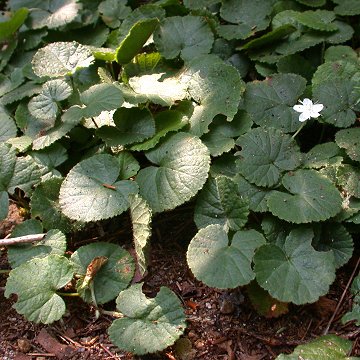

Dalibarda repens - (image 1 of 3)
Taxonomy
Family: Rosaceae
Habitat
Swamps and moist woodlands.
Associates
Clintonia borealis, Coptis trifolia, Cornus canadensis, Epigaea repens, Gaultheria procumbens, Pteridium aquilinum, Vaccinium angustifolium.
Distribution
Quebec and Nova Scotia west to MI and MN, south to NJ and OH.
Morphology
Creeping perennial with slender stems. Leaves simple, cordate, sparsely hairy, to 5 cm; petioles downy. Flowers solitary, of two types; petaliferous flowers white and usually sterile, on long peduncles 5-10 cm long; apetalous flowers self-pollinating, on peduncles less than 5 cm and often recurved. Fruit a 1-seeded drupe, to 4 mm, that resembles an achene.
Notes
Flowers June to September
Wetland indicator: Facultative
This plant is known by several common names including dewdrop and robin-runaway. The leaves could be mistaken for that of violets when this plant is not in flower save for the hairiness of the petiole of the leaf. Like violets, this plant produced both petaliferous and apetalous flowers. This is the only species in the genus Dalibarda in North America. It is very closely related to plant in the genus Rubus.
References
Gleason, Henry A. and A. Cronquist. 1991. Manual of Vascular Plants of Northeastern United States and Adjacent Canada. Second Ed.
The New York Botanical Garden. Bronx, NY
Swink, F. and G. Wilhelm. 1994. Plants of the Chicago Region.
Indiana Academy of Science. The Morton Arboretum. Lisle, Illinois.
|
Michael Hough © 2004 |